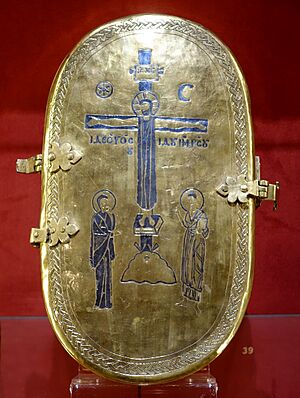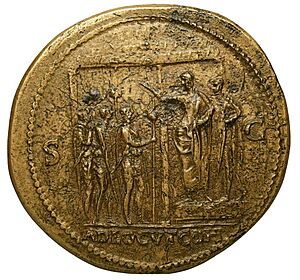Orichalcum facts for kids
Orichalcum (say: oh-ri-KAL-kum) is the name of a mysterious metal. Ancient Greek writers talked about it, and the Romans used a metal they called orichalcum to make coins. However, these two metals might not have been the same!
Today, experts are still not sure exactly what orichalcum was. Some think it was an ancient Greek name for platinum. Others believe it was an alloy, which is a mixture of two or more metals. They think it was a mix of copper and either gold, tin, or zinc. When scientists studied old Roman coins, they found they were made of a mixture of copper and zinc.
Contents
What Does the Name Mean?
The word orichalcum comes from the Greek words meaning "mountain copper" or "mountain metal."
Some people might think the name aurichalcum comes from the Latin word aurum, which means "gold." But this is not correct.
Orichalcum in Ancient Greece
When ancient Greek writers mentioned orichalcum, they often described it as a metal that looked like gold. However, they didn't know much else about it. To writers like Homer, Hesiod, and Plato, orichalcum was a metal from a very long time ago. They believed it no longer existed in their own time.
In one of the Homeric Hymns, Homer wrote about earrings made of orichalcum. Hesiod mentioned leg armor called greaves made from orichalcum. Both writers were talking about a time before their own.
Plato wrote about orichalcum in his famous book Critias. In this story, Plato said orichalcum was found deep in the ground of the legendary island of Atlantis. For the people of Atlantis, it was the second most valuable metal, right after gold. Plato wrote that the Atlanteans used orichalcum to decorate their city walls and temples. He also said that in his own time, orichalcum was "only a name," meaning he had never seen it himself.
Orichalcum in Ancient Rome
The ancient Romans also had a metal they called orichalcum. Around the time the Roman Republic ended and the Roman Empire began, the Romans stopped making coins from bronze. Instead, they started using orichalcum for coins like asses, sestertii, dupondii, and semisses.
Roman orichalcum can corrode over time. This is similar to how iron rusts or silver tarnishes.
How Was Roman Orichalcum Made?
Scientists have studied Roman coins and found they were made of copper and zinc. During the early days of the Roman Empire, the Romans developed a better way to create zinc-copper alloys. This method is called cementation.
To do this, a metalworker had to heat zinc and copper to exactly the right temperature. Using this method, the orichalcum could contain as much as 30% zinc.
Orichalcum in Stories and Games
Orichalcum often appears in many fictional stories, especially those about Atlantis. You might find it in television shows like The Mysterious Cities of Gold and Nadia: The Secret of Blue Water. It also shows up in video games, such as Castlevania: Curse of Darkness and Elder Scrolls.
Images for kids
See also
 In Spanish: Oricalco para niños
In Spanish: Oricalco para niños




